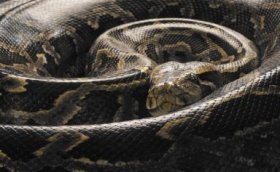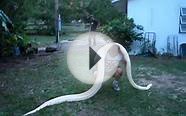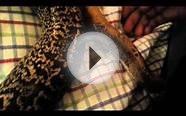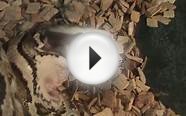Burmese Pythons as Pets
 Tim Flach/The Image Bank/Getty Images
Tim Flach/The Image Bank/Getty Images
Scientific Name:
Python molurus bivittatus
Life Span:
25 years or more
Huge! Expect an adult size of 15-20 feet long, and 100 to 200 pounds or more. Their huge size makes them both expensive to keep and potentially dangerous, so think first about committing to caring for a snake this size. It is not easy to find someone to take a large snake if you can no longer care for it.
Never, ever release your pet - released Burmese pythons have invaded and are breeding in the Florida Everglades and have become a serious threat there. Owners have died due to handling mistakes with these snakes as well - they are not suitable for beginners and are generally best left in the wild.
Temperament:
Burmese pythons are generally considered quite docile especially compared to other large snakes. Hatchlings can be quite skittish but are usually quite readily tamed with consistent handling. Still, these snakes are huge and quite aggressive feeders, and they can inflict serious injury to their handlers and have been involved in several fatalities (due to owner complacency, ignorance, or error). A second person should always be present when handling or feeding constrictors over 8 feet long.
Housing:
A 55 gallon tank is fine for younger snakes, but as the snake grows, a larger and stronger enclosure will be necessary. After the first couple of years options include custom built wood and Plexiglas cages, or modifying a large closet or room for your snake.
These huge snakes are very good escape artists and are very strong, so any housing for these snakes must be large (e.g eight feet long, four feet wide and four feet tall), strong and very secure.
Substrate:
For hatchlings, paper towel or unprinted paper can be used. These are easy to clean and make it easy to monitor the health of the snake. For bigger snakes, indoor/outdoor carpeting is easy to maintain (keep a few pieces on hand and just switch them out when it is time to clean and disinfect). Linoleum is also a good option for large snakes as it is easy to clean and disinfect.
Hides:
For young snakes a half log or other hide sold at the pet store will work (even a cardboard box will suffice), but as they grow you will have to be more creative. Plastic storage bins make good hides for larger snakes - simply cut an access hole in one side (make sure there are no sharp edges though). A humidity retreat should also be provided, especially when shedding, by placing damp sphagnum moss in a hide. Hides should be provided at both ends of the temperature gradient.
Temperatures:
Need a daytime temperature of 85-88 F (29-31 C), with a basking area at 90-93 F (32-34 C). The temperature can drop to 78-80 F (25-27 C) at night. Spotlights, ceramic heat elements, and heating pads can be used to maintain temperatures, but make sure lights are shielded to prevent burns. For large snakes, a pig heating blanket is a good option for maintaining temperature.
Water:
A dish of water should always be available for both drinking and soaking (for smaller snakes). The water will need to be changed frequently. As the snake gets larger it will no longer be able to soak in its dish so you will need to regularly allow the snake to soak in a tub or pool of water.
You might also like












